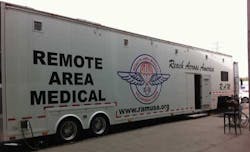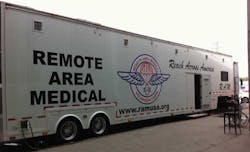Willing and compassionate
A firsthand look at RAM event in Oakland
by Kris Dowling, RDHAP, BA
Driving toward the Oakland Coliseum parking lot, I got butterflies in my stomach – the good kind. The attendant at the gate asked with a smile, "Volunteer?" The dawn was barely breaking, and there was a chill in the early April morning air. The attendant's smile was such a warm greeting; it set the tone for my day as I smiled back, happily acknowledging the title "volunteer."
Entering the coliseum, I sensed that this was a well-designed operation. Greeters worked at various tables, distributing nametags and offering information on where each particular volunteer should report. Several different types of health-care professionals were at this event, including dental, vision, and medical – all volunteers. This place was busy as honeybees during peak production, different from the sealant clinics I had volunteered for. Hearing about this opportunity through my local dental hygiene component, I knew it was something I had to do.
Remote Area Medical, otherwise known as "RAM," was hosting a Northern California expedition in both Sacramento and Oakland, four days at each site. RAM is a nonprofit, volunteer organization created in 1985 that is "...dedicated to serve mankind by providing free health care, dental care, eye care, veterinary services, and technical and educational assistance to people in remote areas of the United States and the world." The founder of this group, Stan Brock, had a vision to bring basic health care to those in desperate need, such as people in remote areas and/or financial poverty. Mr. Brock has personal experience with lack of medical help as he lived 15 years in the Amazon rain forest with the Wapishana Indians where access to care was, for all intents and purposes, nonexistent. He witnessed the death and devastation that could have been avoided given basic medical care. His vision of creating a means for no-cost health care has become an ever-expanding reality.
Once I found the group of hygienists in the coliseum, I noticed a couple of women who appeared to be our "fearless leaders." They were instructing the dental hygiene volunteers about the flow of instrument pick up, patient waiting area, instrument drop off, and workspace cleaning. It was advised we try to see one patient every 20 to 30 minutes if possible since there were approximately 500 people outside who had been waiting through the night. We were told of a woman from the previous day who waited overnight with her 4-month-old baby, and wasn't seen until 3 p.m. It was said the baby was not crying or fussy, and the mother was so grateful for the opportunity to get some much needed health care. We were told that we would receive much more than we would be giving that day. The energy all around was positive and optimistic.
The two dental hygienists leading the hygiene team that day had been involved with the Sacramento RAM theNancy Downend, RDH, right, administers treatment in Oakland, Calif.
"My heart wanted to serve and RAM was the vehicle to do it," she said.
Nancy has gone to Central America several times and volunteered under difficult situations. She humbly stated that she "was just a volunteer like every other hygienist [at RAM]." After her visits to Central America, Nancy called the expedition with RAM "the Ritz of remote dental clinics" in that we had "access to dental chairs and head lamps, suction and compressed water." Not only that, but RAM has "a complete sterilization area and instruments that are handled within the guidelines our state demands."
Nancy's spirit shines as she advocates, "If I could speak to our entire profession for a few minutes at once, I would explain that RAM needs us, people in our country need us, and will not be able to give us a paycheck for our services. Instead, they will return the smiles we gave them with gratitude that money can't purchase. It will not fill your wallet, but it will fill your heart."
While Nancy may not have felt like a "leader," her tireless actions spoke volumes as she participated in both Sacramento and Oakland expeditions, giving hour upon hour of herself and her talents.
Our patients came in carrying blankets, sleeping bags, heavy jackets, backpacks, and stadium chairs. As I took my first patient back to clean his teeth, I asked, "How long have you been waiting?" He replied with a tired smile, "Since about midnight, but it's OK."
After reviewing his health history, I positioned the portable chair and light so I could get to work. "How long has it been since you've had your teeth cleaned?" I asked.
"Mmmm, I don't know, maybe 10 years?" he stated with uncertainty. Instantly, I wondered how in the world can I help this man in 20 to 30 minutes? As any hygienist would imagine, cleaning this man's teeth after his prolonged lapse of care was challenging without question. Not once did he wince, or complain as I worked quickly, to the best of my ability, with my ultrasonic, and when he was "finished" he sat up, smiled, took my hands in his and said with heartfelt acknowledgment, "Thank you so much for volunteering today. Thank you for cleaning my teeth." My heart was bursting with joy after only one patient.
Immediately after my first patient, a team of two volunteers arrived to empty the collection container and refill the water bottle for the portable unit I was working at. It was a bit like a "pit stop" at a car race I imagined, but instead of changing my tires, my unit was being "rotated" by this amazingly fast team of two. I occasionally caught a glance at these volunteers as they cordially went around all day from unit to unit.
A hygienist who could no longer perform clinically due to carpal tunnel syndrome, but still wanted to volunteer was running the instrument pick-up area. She kept the flow of sterilized instruments and trays humming along for each clinician in need of a new setup. There were volunteers for equipment maintenance, ultrasonic unit distribution, patient guidance, dental hygiene assisting, etc. The longer I was there, the more the workforce amazed me. This was humanity at its best – people helping people, and doing so willingly.
The 2009 data on poverty in Oakland, Calif., shows that individuals living below the poverty line, $22,050Each patient I treated that day had waited overnight in order to get free medical attention, and they were full of humility and gratitude for this opportunity. It was the job of each hygienist to provide oral prophylaxis, place fluoride varnish, and refer our patients for X-ray and further treatment if needed.
Even though each person being treated was seen in triage first to determine their greatest urgency of need, some people had several urgent health-care needs. We saw abscesses, severe bone loss, loose teeth splinted together by supragingival calculus, halitosis, gingivitis, periodontal disease, suppuration, ill-fitting dentures, failing restorations, and hope in the eyes of those we treated. I can only imagine this hope may have come from the mere act of someone caring for them, although I don't really know. What I did know is that I was glad to be part of it all.
RAM has a system of keeping track of the number of patients treated and the types of procedures performed by the health-care providers. While this is not a foolproof system in that it requires humans to fill out a bit of paperwork, it can provide an estimate. It was reported that between the Sacramento and Oakland clinics, there were over 2,136 volunteers.
Stan Brock was quoted as saying that these clinics "were the best RAM has had" and what makes a clinic the best is "the friendliness of [the] volunteers, appreciation from the patients, location, and organization of the event."
Early statistics are showing that 6,600 patients were seen in Sacramento and Oakland with 4,700 of them being treated by dental professionals. There was a recorded 5,500 fillings, 1,600 cleanings, 3,600 extractions, and 1,400 panorex X-rays taken. To place a dollar value on those services, it would be somewhere in the neighborhood of $2.5 million dollars, but what was given was priceless, and what was received from the people treated surpassed even that.
The only regret I have surrounding this event is that I didn't participate more. RAM is able to exist because of its volunteers and donations. Everything available to the health-care practitioners is donated: instruments, disposables, ultrasonics, X-ray equipment, sterilizers, etc. It looks like RAM will be making an encore appearance in 2012 to Northern California as well as Los Angeles, but rest assured, there are expeditions across the nation and to other parts of the world for those interested.
Stan Brock adds on the RAM website that our talents can be utilized no matter the capacity. "You just need to be willing and compassionate."
Kris Dowling, RDHAP, BA, began her career in dentistry 27 years ago, first as a certified dental assistant, then as a registered dental hygienist. She holds a business management degree from St. Mary's College of California, and graduated the RDHAP program from University of the Pacific in San Francisco. Kris works part time in private practice in Berkeley, Calif., and is the owner of Dental Hygiene Delivered, her mobile dental hygiene business. Kris is a proud member of the American Dental Hygienists' Association, the California Dental Hygienists' Association, and Mt. Diablo Dental Hygiene Society where she volunteers her time on the executive board.
References
http://www.ramusa.org/index.html
http://www.bls.gov/web/metro/laulrgma.htm
http://www.city-data.com/poverty/poverty-Oakland-California.html
http://www.workingeastbay.org/downloads/Putting_Oakland_to_Work.pdf
Past RDH Issues



